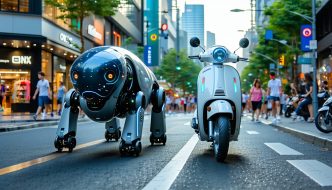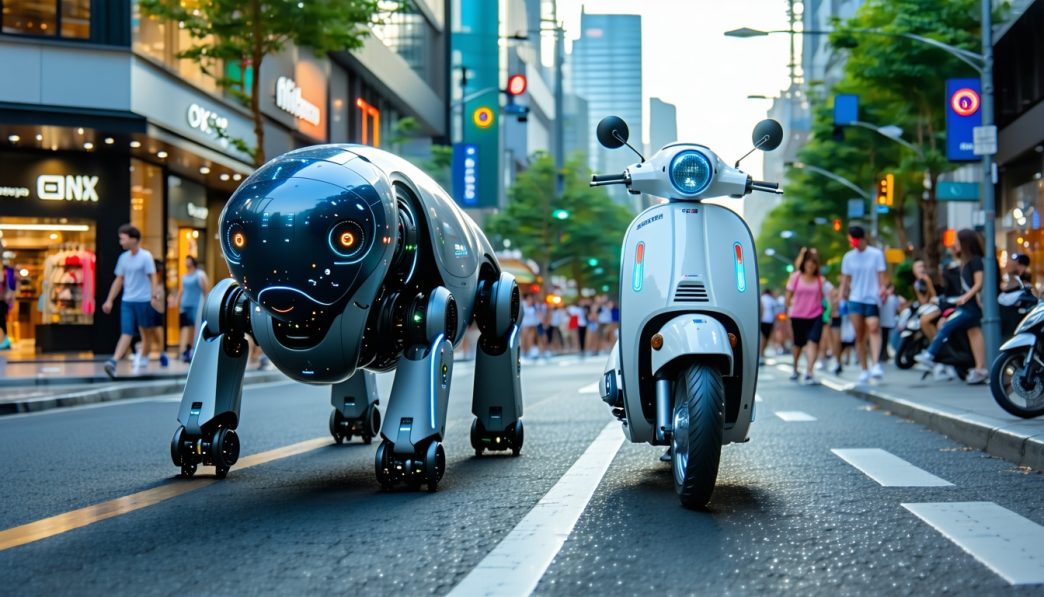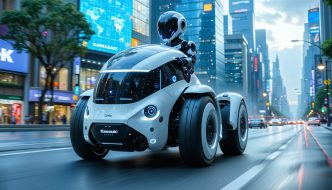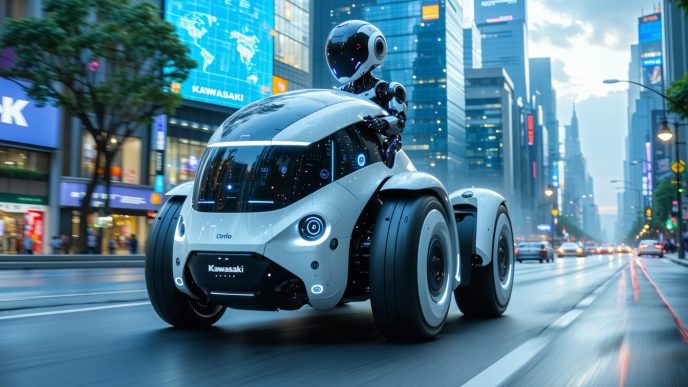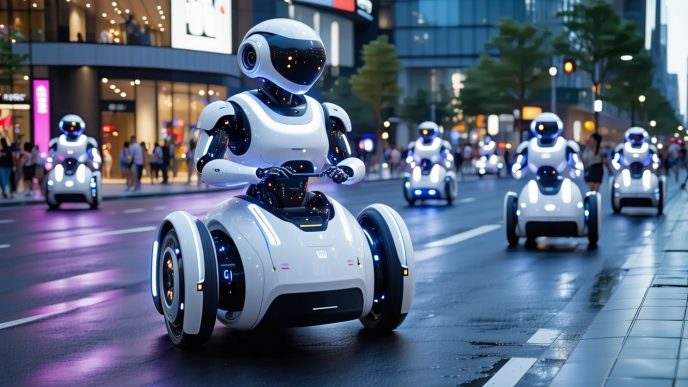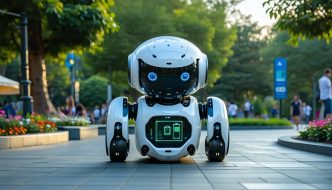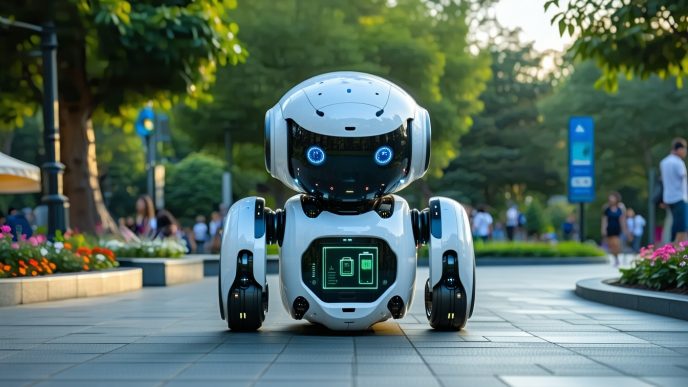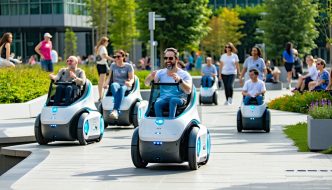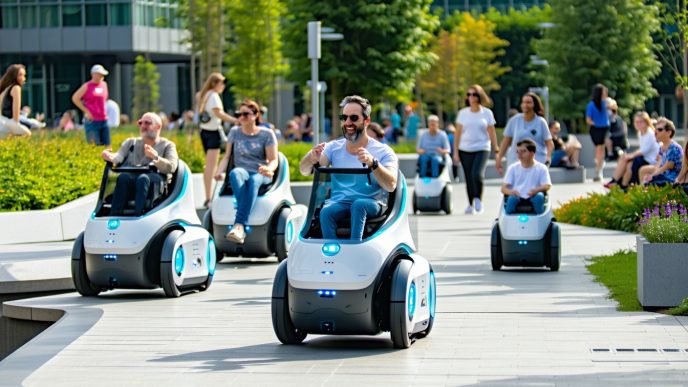Rideable Robots and Electric Scooters: A Practical Comparison
Introduction to Rideable Robots and Electric Scooters
As technology evolves, new forms of transportation emerge, making it essential to evaluate options for mobility. Among them, rideable robots and electric scooters are gaining attention. Rideable robots, specifically quadrupeds, offer unique features that cater to convenience and adaptability, while electric scooters provide an established mode of transport favored for urban commuting.
This comparison explores their functionalities, suited applications, and overall effectiveness in various settings. Understanding the distinctions between rideable quadrupeds vs scooters helps professional users, business owners, and tech-savvy homeowners identify the right solution for their mobility needs.
Use Cases and Practical Applications
Both rideable robots and electric scooters offer significant advantages in distinct scenarios. Below is a table summarizing their primary use cases and applications:
| Mode of Transportation | Use Cases | Practical Applications |
|---|---|---|
| Rideable Quadrupeds | Elderly and disabled mobility | Assistance in navigating homes or public spaces; rideable robots for disabled mobility |
| Terrain exploration | Outdoor activities or working in rough terrains | |
| Security and surveillance | Patrolling areas as per programmed routes | |
| Electric Scooters | Urban commuting | Daily transportation to work or school |
| Quick errands | Small deliveries or personal shopping | |
| Recreational use | Leisurely rides in parks or city centers |
Each mode serves specific purposes contributing to enhancing mobility and efficiency. For instance, rideable robots can tackle diverse terrains with ease, making them suitable for situations that electric scooters cannot handle. Meanwhile, scooters stand out in urban settings for their speed and ease of use.
In the following sections, detailed insights on the features, functionality, and practical implications of both rideable quadrupeds and electric scooters will further clarify their respective advantages in various contexts.
Rideable Quadrupeds: The Future of Mobility
Features and Functionality of Rideable Quadrupeds
Rideable quadrupeds encompass a new category of mobility solutions designed for both personal and commercial use. These robotic systems often mimic animal movements, providing stability and agility over various terrains. Key features include:
- Dynamic Balance: Advanced sensors and gyroscopic technology help maintain balance and stability, allowing the quadruped to navigate uneven surfaces.
- Versatility: Capable of traversing diverse environments—urban landscapes, natural trails, and indoor settings—rideable quadrupeds adapt to multiple scenarios.
- User Interface: Many systems come equipped with intuitive controls, often using mobile app connectivity for easy navigation and monitoring.
- Payload Capacity: Different models can carry varying loads, making them suitable for transporting items in commercial applications or assisting individuals with mobility challenges.
Below is a comparison of features for typical rideable quadrupeds:
| Feature | Description |
|---|---|
| Speed | 5-10 mph (8-16 km/h) |
| Range | 10-30 miles (16-48 km) on a single charge |
| Weight Capacity | 200-400 lbs (90-180 kg) |
| Terrain Adaptability | Off-road, grass, gravel, paved surfaces |
Pros and Cons of Rideable Quadrupeds
Like any emerging technology, rideable quadrupeds come with a unique set of advantages and disadvantages.
| Pros | Cons |
|---|---|
| Enhanced mobility in challenging terrain | Higher initial cost compared to electric scooters |
| Ability to assist individuals with mobility impairments | Requires more maintenance due to mechanical complexity |
| Can carry substantial payloads for various applications | Larger footprint may limit use in crowded settings |
| Provides a stable ride, reducing the risk of falls | Learning curve associated with operating advanced controls |
| Environmentally friendly options available | Battery life concerns for extended use, see battery life of rideable robots |
The rise of rideable quadrupeds as a mobility option presents significant implications for both personal transportation and commercial logistics. Their ability to enhance accessibility and provide reliable movement across various terrains makes them a compelling alternative when comparing rideable quadrupeds vs scooters. For more information on the versatility of robotic solutions, visit our articles on rideable robots and robot horses and animal inspired bots.
Electric Scooters: A Popular Choice for Urban Mobility
Electric scooters have gained significant popularity as a practical means of urban transportation. These devices offer convenience and efficiency, making them an appealing option for professionals, business owners, and tech-savvy individuals.
Features and Functionality of Electric Scooters
Electric scooters are designed to provide a simple and effective solution for short-distance travel. The key features and functionality include:
| Feature | Description |
|---|---|
| Speed | Electric scooters typically reach speeds of 15-20 mph, making them suitable for urban commutes. |
| Range | Most models can travel between 15-30 miles on a single charge, depending on the battery capacity. |
| Weight Capacity | Generally accommodate weights ranging from 220 – 300 lbs comfortably. |
| Folding Mechanism | Many electric scooters can be easily folded for transport and storage, enhancing portability. |
| Braking System | Equipped with electronic, disc, or drum brakes to ensure rider safety. |
| Connectivity | Some models include smartphone connectivity for tracking, navigation, and performance insights. |
Electric scooters are favored for their lightweight design and ease of use. They have a simple control mechanism, usually involving a throttle and handlebar, which allows for smooth rides in urban environments.
Pros and Cons of Electric Scooters
When evaluating the practicality of electric scooters, it is essential to consider their advantages and drawbacks.
| Pros | Cons |
|---|---|
| Convenient for short trips and easy handling in dense urban areas. | Limited range may require frequent charging. |
| Generally lower in cost compared to rideable robots. | Vulnerable to theft if left unattended. |
| Lightweight and portable, facilitating easy storage and transport. | Affected by weather conditions and not suited for all terrains. |
| Minimal maintenance compared to larger transport options. | Battery degradation may impact longevity and performance. |
While electric scooters provide a practical solution for many urban mobility needs, it is vital to compare their functionalities against other options like rideable quadrupeds. Insights into the benefits and challenges of both forms of transportation can be found in various articles on rideable robots and related advancements in robotics, such as the kawasaki corleo robot and the xiaomi cyberdog 2 rideable concept.
Practicality in Different Settings
Exploring the practicality of rideable quadrupeds and electric scooters involves assessing their use in various settings, particularly at home and in commercial environments. Each option presents unique features and benefits that cater to distinct needs.
Home Use: Rideable Quadrupeds vs Electric Scooters
When considering home use, both rideable quadrupeds and electric scooters provide varying functionalities.
| Feature | Rideable Quadrupeds | Electric Scooters |
|---|---|---|
| Maneuverability | High, can navigate uneven terrain | Moderate, suited for smooth surfaces |
| Transport Capacity | Can carry additional load (e.g., groceries) | Limited to rider only |
| Space Requirements | Requires more storage space | Compact and easily stored |
| Accessibility | May assist individuals with mobility issues | Primarily for personal transport |
Rideable quadrupeds can serve multiple roles in home environments, providing assistance to individuals with disabilities or enhancing outdoor activities such as exploring nature. For more information on rideable robots designed for mobility assistance, visit our article on rideable robots for disabled mobility.
Electric scooters, on the other hand, excel in providing quick and convenient transport for short distances around neighborhoods or urban settings. They are easy to use and maintain, making them a popular choice for tech-savvy homeowners looking for efficient mobility options.
Business and Commercial Use: Rideable Quadrupeds vs Electric Scooters
In a commercial context, both rideable quadrupeds and electric scooters find practical applications, although their effectiveness may vary.
| Feature | Rideable Quadrupeds | Electric Scooters |
|---|---|---|
| Load-Bearing Capacity | Can transport equipment or products | Limited to rider only |
| Terrain Adaptability | Suitable for diverse terrains (construction sites, parks) | Best on pavement and flat areas |
| Compliance and Safety | Requires adherence to specific regulations | Requires safety measures and guidelines |
| Operational Cost | Potentially higher maintenance costs | Generally lower operational costs |
Rideable quadrupeds could be valuable in professions requiring mobility in challenging environments, such as construction sites, where they can transport tools or equipment to workers in difficult terrain. For insights on innovative robotic concepts, see our article on the kawasaki corleo robot.
Electric scooters, however, remain highly practical for urban delivery services or businesses with flat surfaces. They are cost-effective and offer a speedy solution for employees commuting or executing deliveries.
In summary, understanding the differences between rideable quadrupeds and electric scooters allows professionals and business owners to make informed decisions based on their specific needs and operational contexts.
Efficiency and Cost Considerations
Maintenance and Operating Costs
When assessing the practicality of rideable quadrupeds versus electric scooters, it’s essential to consider the maintenance and operating costs associated with both options. The costs can vary based on technology, usage frequency, and required upkeep. Below is a comparison of the average costs involved in maintaining and operating both rideable quadrupeds and electric scooters.
| Item | Rideable Quadrupeds | Electric Scooters |
|---|---|---|
| Initial Purchase Cost | High ($5,000 – $15,000) | Moderate ($300 – $1,500) |
| Annual Maintenance Cost | Moderate ($500 – $1,000) | Low ($50 – $200) |
| Battery Replacement (if needed) | High ($1,000 – $3,000) | Low ($100 – $300) |
| Insurance Cost | Variable ($200 – $600) | Variable ($50 – $150) |
Rideable quadrupeds often come with higher initial costs and maintenance expenses, primarily due to their advanced technology and sophisticated functionalities. Electric scooters, while substantially lower in purchase price, can also incur costs related to battery replacement over time.
Environmental Impact
Both rideable quadrupeds and electric scooters have unique environmental considerations that professionals and tech-forward homeowners can evaluate. Here is a summary of their environmental impact:
| Aspect | Rideable Quadrupeds | Electric Scooters |
|---|---|---|
| Energy Source | Primarily electric, varying based on battery type | Electric, typically lithium-ion batteries |
| Emissions | Zero direct emissions during operation | Zero direct emissions during operation |
| Manufacturing Impact | Higher resource use due to advanced components | Lower resource use, generally simpler design |
| End-of-Life Recycling | Limited recycling options for sophisticated materials | Higher recyclability for battery and frame material |
Rideable quadrupeds produce zero emissions during use, which is beneficial for urban environments. However, the manufacturing and disposal processes can have significant environmental impacts. Electric scooters also generate no emissions while being easier to recycle, making them a more environmentally friendly option when considering the full lifecycle impact.
By evaluating maintenance costs and environmental considerations, professionals and business owners can make informed decisions when comparing rideable quadrupeds versus scooters.
User Experience and Customization
When considering the user experience for rideable robots and electric scooters, aspects such as comfort, ergonomics, and options for customization play crucial roles. Understanding these factors can assist professionals, business owners, and tech-savvy homeowners in making informed decisions regarding mobility solutions.
Comfort and Ergonomics
Comfort is a significant factor that impacts the user experience for both rideable quadrupeds and electric scooters. Rideable quadrupeds are designed to provide stability and support, which is important for longer durations of use. Attractive ergonomic features, such as adjustable seats and footrests, enhance the overall experience.
Electric scooters, on the other hand, often focus on lightweight design and maneuverability. Their handlebars can typically be adjusted for height, catering to a range of riders. However, they may lack additional support features that rideable quadrupeds provide.
| Feature | Rideable Quadrupeds | Electric Scooters |
|---|---|---|
| Seat Adjustability | Yes | No |
| Handlebar Adjustability | Limited | Yes |
| Stability | High | Moderate |
| Weight Distribution | Optimized for balance | More reliant on rider’s balance |
Customization Options
Customization is another important consideration for both categories. Rideable quadrupeds may offer options for configuring ride settings, including speed and handling preferences, to cater to individual riding styles. Additionally, they may have modules that allow for attaching various accessories suited for different tasks.
Electric scooters often come with a range of customization features, from color options to handle grips and wheels suited for urban or off-road environments. Many scooters also allow users to personalize their riding modes through integrated apps. This flexibility can enhance user satisfaction and fit diverse lifestyle needs.
| Customization Feature | Rideable Quadrupeds | Electric Scooters |
|---|---|---|
| Speed Settings | Yes | Limited to preset modes |
| Accessory Attachments | Yes | Limited |
| Color Options | Limited | Extensive |
| App Integration | No | Yes |
Understanding comfort and customization options offers insight into how rideable quadrupeds and electric scooters differ in enhancing user satisfaction. Depending on the intended use case, be it for business operations or personal commuting, the choices can directly influence usability and enjoyment. For further information about the innovations in rideable robots, see our article on rideable robots.
Integration and Adaptability
Compatibility with Smart Home Systems
As technology advances, the integration of rideable robots and electric scooters with smart home systems is becoming increasingly important. Professionals and tech-forward homeowners want devices that seamlessly connect with existing technologies to enhance efficiency and convenience.
Rideable quadrupeds often feature advanced sensors and connectivity options that allow them to communicate with smart home devices. This includes compatibility with voice-activated assistants and home automation systems. For instance, they can be programmed to navigate autonomously to specific locations while coordinating with home security systems or adjusting home climate settings based on user preferences.
Electric scooters also offer some connectivity features, primarily focusing on navigation and real-time updates via mobile applications. However, their integration is generally less comprehensive compared to rideable quadrupeds due to their simpler functionality.
| Feature | Rideable Quadrupeds | Electric Scooters |
|---|---|---|
| Smart Home Compatibility | High | Moderate |
| Voice-Activated Control | Yes | Limited |
| Navigation Integration | Advanced | Basic |
Potential for Future Upgrades and Enhancements
The potential for upgrading and enhancing both rideable quadrupeds and electric scooters is a critical factor for users looking for long-term value. Rideable robots typically come with modular designs, enabling users to swap out parts or add new functionalities over time. This adaptability ensures that as technology improves, these companions can evolve to better meet user needs.
For example, rideable quadrupeds may have capabilities for added functionalities like payload delivery or enhanced navigation software. This upgrade potential aligns with the growing demand for versatile robots that can serve multiple purposes within home or commercial settings.
In contrast, electric scooters tend to have limited upgrade paths due to their relatively consistent design and functionality. Users might face challenges in adapting them to emerging technologies or features.
| Upgrade Potential | Rideable Quadrupeds | Electric Scooters |
|---|---|---|
| Modular Components | Yes | No |
| Software Enhancements | Frequent | Rarely |
| Functional Add-ons | High | Limited |
Both rideable quadrupeds and electric scooters have their unique advantages regarding integration and adaptability. The choice between them should be informed by the specific needs of users looking for practical solutions in home or business environments. For more insights on the effectiveness of these technologies, visit our article on rideable robots.

